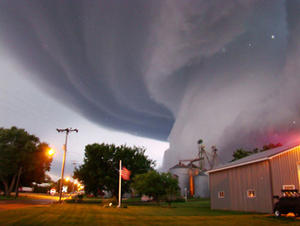Bio labsKansas biolab project on life support
In 2008, DHS chose Manhattan, Kansas, as the location for a new, $650 million BioLab Level 4; the new lab was planned as a replacement for the aging Plum Island facility; critics argued that the lab’s location — in the middle of Tornado Alley and at the center a region which is home to a large portion of the U.S. beef industry – was not ideal for a facility doing research on deadly animal and human pathogens; it now appears that budgetary considerations have doomed to project

Tornado alley, proximity to beef herds and budget constraints jeopardize the Kansas biolab // Source: yume.vn
The first budget submitted by the Obama administration to Congress three years ago sharply reduced the funds allocated to the Yucca Mountain nuclear waste repository project. This initial defunding offered an early indication that the administration was moving to kill the project.
The budget the Obama administration submitted to Congress on Monday contains a similar defunding indication. This time, the administration asked for no funds for building a new BioLab Level 4 in Manhattan, Kansas (the official name is the National Bio and Agro-Defense Facility [NBAF]). That lab, the price tag for which would have been $650 million, was supposed to replace to aging Plum Island Animal Disease Center off Long Island.
It appears that at least one of the reasons for the administration’s decision was the weak U.S. real estate market. Science reports that the administration was hoping to raise a large portion of the funds needed to build the Kansas facility by selling Plum Island to real estate developers, but there were no takers.
Kansas was awarded the lab in 2008 after a tight competition among six finalists. The losers in the competition joined environmentalists and the livestock industry in criticizing the lab location. They noted that Manhattan, Kansas, was in the middle of Tornado Alley, and that it would be subjected to sever and punishing storms.
Moreover, agricultural interests pointed out that a large percentage of the U.S. beef industry is located on ranches, farms, and feed lots within two hundred miles of the new lab location. If a pathogen were to escape the confines on the lab either as a result of accident or terrorist act, the economic consequences might be devastating.
In 2009, the Government Accountability Office harshly criticized DHS for not paying sufficient attention to the concerns about Tornado problem.
Last year the administration requested $150 million to continue work on the project, but Congress appropriated only $50 million, stipulating the money could be used for studies only, not for construction.
Tara O’Toole, the head of DHS’s science and technology directorate (S&T), said DHS did not request funds for the project in the 2013 budget so the agency could take its time studying the project. “What we are going to do beginning this spring is set up a task force in conjunction with the U.S. Department of Agriculture and [the Department of] Health and Human Services that will take a comprehensive look at the current threat spectrum from terrorism to foreign invasive species to new zoonotic diseases,” she said. “We are going to ask the question, do we need to build a BSL-4 lab to tackle these threats — yes or no? And is there an alternative to doing that?” O’Toole said that if the answer is yes, DHS could make the case to the White House for reinstating the plan in next year’s budget.
The Kansas City Star quotes another DHS official to say: “We’re committed to the capabilities a facility like NBAF provides, and the importance of it to our long-term security… [But it must be re-evaluated] “in the current budget environment, evaluating the cost, safety and capabilities of the current plan.”
Governor Sam Brownback and Kansas’s congressional delegation issued a statement saying further review of merits of the facility is needless and “a waste of taxpayer dollars.” The National Hog Farmer quotes the statement to say that “This change of direction is unacceptable and will leave our country vulnerable…. Kansas has won every competition, met every standard and proven its commitment to this project, and we’ll do whatever it takes to fulfill this critical national security need.”
Opponents of the lab applauded the decision. “This is an opportunity for a more reasoned and balanced evaluation of what this community has to offer and stands to benefit” from NBAF, Tom Manney, a retired K-State professor who helps run an opposition group called No NBAF, told the Kansas Star.
He said that includes Manhattan residents and the neighboring livestock producers as well as Kansas State University where the building would be constructed. “Our major criticism has been that the initial NBAF is not a good fit for this location, with its concentration of livestock operations, limited medical support facilities, and the congested university activities,” Manney said.
Also applauding DHS decision were activists on Long Island who lobbied for Plum Island to remain open. Adrienne Esposito, executive director of the Long Island-based Citizens Campaign for the Environment, said the budget recommendation was good news.
“The future of this facility is on Plum Island, and even the president realizes moving this would be a big mistake,” Esposito said. “The Plum Island laboratory should stay on Plum Island. We shouldn’t be fixing what isn’t broken.”
